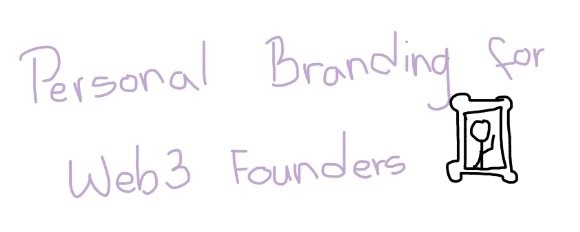Personal Branding for Web3 Founders: Why It Matters More Than Your Tech

In Web3, having the best tech doesn’t always win. Distribution, trust, and narrative matter more, and that’s where personal branding comes in. The most successful founders in this space build more than products. They build belief.
Whether you're a solo builder, part of a stealth team, or leading an ecosystem project, developing your personal brand is one of the highest-leverage things you can do. In this post, we’ll break down why it’s essential and exactly how to do it in a way that drives adoption, builds trust, and scales your message.
Why Personal Branding Is Non-Negotiable in Web3
Let’s start with the hard truth: people don’t trust people, more than they do tech.
Web3 is built on ideals like decentralization, permissionlessness, and anonymity. But ironically, it’s one of the hardest spaces to build trust in. Scams, vaporware, and anonymous teams are common. As a result, users crave real human connection more than ever.
When people can see and hear from the founder behind a project, trust builds faster. It shortens sales cycles. It reduces skepticism. It helps differentiate your project in a market where the tech often sounds the same.
A founder with a strong personal brand becomes a beacon. They become someone to follow, listen to, and believe in, even before someone tries their product. That influence is distribution. And distribution is everything.
The Three Pillars of a Personal Brand in Web3
1. Know Your Audience
Your personal brand isn’t for everyone. It’s not supposed to be.
Trying to speak to everyone waters down your voice. Instead, get razor-sharp on who you're talking to. Are you building for developers, DeFi users, creators, or infrastructure teams? Understand their pain points, hopes, and vocabulary.
When you know your audience, you can create messages that resonate deeply. You become someone who “gets it”, and that’s powerful.
2. Demonstrate Thought Leadership
You don’t need to be loud. But you do need to be visible and thoughtful.
Thought leadership means contributing to conversations, not just reacting. It’s about sharing your unique insights on how the space is evolving, what your team is learning, and why your product matters.
Everyone on your team can participate. Business development team members, for example, can share insights from partnerships or market trends they’re seeing. Engineers might discuss interesting trade-offs or performance wins. Even junior staff can post takeaways from recent challenges they’ve faced.
This signals two things:
- You’re actively thinking about the future of the space.
- You’re aligned with a project worth following.
3. Show Your Personality
Don’t be a robot.
People connect with people. Share your voice. Be a little weird. Use memes, tell stories, post about your routines, travels, or gym sessions. It makes your feed more human and your audience more invested.
A personal brand isn’t just about professional updates. It’s about storytelling. When people feel like they know you, they root for you.

How to Build a Personal Brand That Works
Pick the Right Platforms
Start where your audience already is:
- X (Twitter) is a must-have for 99% of Web3 founders.
- LinkedIn adds credibility and reaches a professional crowd.
- YouTube and podcasts help you go deep and build trust with longer-form content.
Telegram and Discord are great for community but less ideal for building outward-facing brand equity. Start with one or two platforms and master them. Don’t try to be everywhere.
Use X Pro dashboards to curate the right conversations. Set up lists of VCs, builders, and other founders. Spend 30 minutes a day engaging and tracking topics. Over time, this compounds into real visibility.
Create With Purpose
Your content should do three things: inform, engage, and relate.
Here’s what to share:
- Trending topics: Give your take on big events or emerging narratives.
- Behind-the-scenes insights: Talk about what it’s like building your project.
- Personal challenges: Share what’s hard, what you’re learning, and what’s next.
- Product breakdowns: Explain what you’re building and why it matters.
- Big-picture storytelling: Show how your project fits into the future of Web3.
Be willing to document, not just polish. People don’t want perfection, they want realness. Share how your mainnet launch went. Talk about delays. Celebrate milestones and lessons.
And remember: type how you talk. Simple language beats jargon every time.
Tell Your Story (and Sell the Vision)
You’re doing more than just promoting a product. You’re building a movement.
Your job is to sell the faith, why your product matters, why the blockchain future is exciting, and what role you’re playing in it. Paint a clear vision. Help your audience see themselves in the future you’re building.
Take inspiration from people like Nick White, Celestia’s COO. He frames the concept of data availability in multiple ways (RAM for the world computer, a foundation for the new internet) and reinforces his product’s importance through consistent storytelling.
Talk about your long-term vision. Not just what happened this week, but what you're building toward over the next year or five. Give people a reason to believe.

Beyond Content: Engage to Grow
Creating content is only half the game. The other half is showing up.
Engage with other voices. Join debates. Leave thoughtful comments. Collaborate with other founders and teams. When people see you consistently show up, your brand becomes part of the conversation.
This is about more than reach, it’s about credibility. Being present reinforces that you care, that you’re paying attention, and that you have something to add.
If you only post and never reply, your personal brand becomes a billboard. And billboards don’t build relationships.
Use comments as conversations. Turn DMs into meetings. Leverage podcasts and X Spaces to connect live. Web3 is still early, and founders who show up, win.
Be Bold. Be Authentic.
This space moves fast. Ideas shift. Narratives change.
Don’t be afraid to have opinions. You won’t resonate with everyone, and that’s okay. Speak from your values. Disagree respectfully. Share bold ideas. Show your human side, including the setbacks.
You’re not here to blend in. You’re here to build belief.
So be yourself. Be consistent. And be clear about what you stand for. That’s how you turn your name into a magnet.
Want help turning your founder journey into a powerful personal brand? Book a strategy call to start building a brand that earns trust and drives traction.

